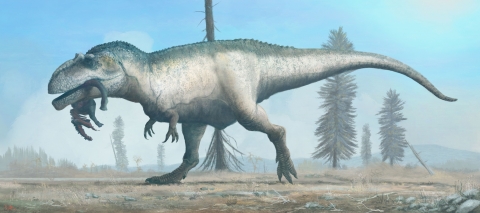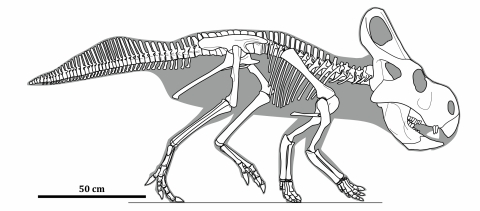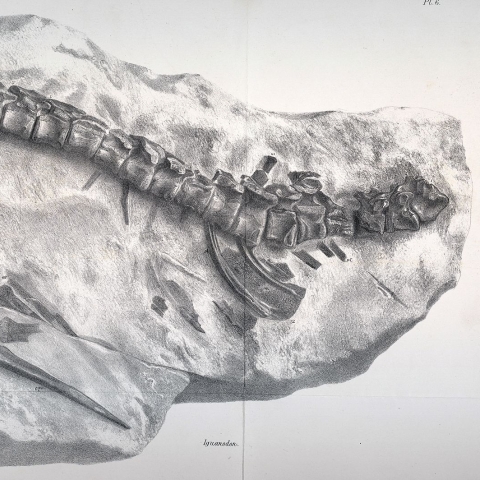

To celebrate National Draw a Dinosaur Day (30 January) Dr Mark Witton, Palaeontological artist and Visiting Researcher, shares his love of drawing dinosaurs and offers his top tips to bring these ancient reptiles back to life on paper.
5 minutes
If you need an excuse to sketch a Stegosaurus or doodle a Diplodocus, today is your day: Draw a Dinosaur Day 2024 is upon us. Illustrating dinosaurs and other extinct life is not only great fun and potentially educational, but reminds us that palaeontology, the study of fossils, is one of the most accessible of all sciences. How many of us have visited museum dinosaur skeletons and not wondered what they looked like when alive? Answering this simple question is tricky, however. Living dinosaurs, the birds, give us many insights into the appearance of their extinct relatives, but it’s hard to mentally stretch a blackbird into a Brontosaurus even with the most liberal application of imagination.

Dr Mark Witton
To visualise dinosaurs as accurately as possible, we therefore turn to palaeoartists, individuals who use a science-led process to recreate the appearance of extinct organisms in paintings, sculpture and animation. The popularity of dinosaurs has made them some of the most frequently depicted species in the two-century history of palaeoart, and we can trace all these efforts back to the oldest-known attempt to restore a dinosaur in 1831. This image featured the predatory species Megalosaurus, the first dinosaur to be named and, coincidentally, a dinosaur that will shortly celebrate the 200th anniversary of its naming on February 20th.

The evolution of the Megalosaurus, from the oldest-known attempt to restore a dinosaur in 1831 to Dr Witton's modern interpretation.
Scientists of 1831 imagined Megalosaurus as a gigantic lizard, but over time, that concept changed. It soon became an upright, bear-like quadruped, then into a sail-backed biped, and eventually the mid-sized, short-armed predatory dinosaur creature we imagine today. These alterations reflected developments in dinosaur science rather than artistic whimsy. Well-made palaeoartworks are always a reflection of the science of their time, and the history of the discipline is a visual record of palaeontological interest and hypotheses.
Today, the science informing considerations of dinosaur life appearance is very advanced. When a palaeoartist looks to draw a dinosaur, they don’t merely glance at a fossil and then draw whatever they like. They carefully note the proportions suggested by dinosaur bones, meticulously work out where muscles were attached, and extract data on fossil skin, and sometimes even colour, from fossil remains and scientific papers. During this process, one eye is kept on living animals to ensure our reconstructions are grounded in reality and to answer questions that fossils cannot. What sort of colours and patterns are associated with certain lifestyles? How bulky or skinny can healthy animals be? Fossils can’t necessarily tell us, but we can gauge possibilities from living species.

Tyrannosaurus muscle study image.
The realistic goal of most palaeoart is not to present a true-to-life vision of deep time. This ideal might be close to achievable for a few species, but fossil data is generally too patchy to tell us everything we need to restore extinct species exactly as they were. Instead, we aim to be in the right ballpark; to present a vision of an extinct species that satisfies our best scientific expectations of their form, and that employs reasoned, intelligent insights on living species to fill knowledge gaps. Thus, what might be a satisfactory take on a dinosaur species changes from one year to another. Who knows what some of our favourite dinosaurs might look like for Draw a Dinosaur Day 2025
Are you drawing a dinosaur today? Five useful tips
- If you want to play by the rules of the day, ensure you draw a dinosaur. Often confused with other prehistoric animals, like the flying reptiles (pterosaurs), the marine reptiles (the four-flippered plesiosaurs, dolphin-like ichthyosaurs and swimming lizards, the mosasaurs), and even fossil mammals like mammoths, dinosaurs are a specific group of terrestrial reptiles that comprise predatory bipeds (Tyrannosaurus, Velociraptor, Megalosaurus), long-necked herbivores (Diplodocus, Brontosaurus), and beaked herbivores (Triceratops, Stegosaurus, Iguanodon). Birds are members of the predatory dinosaur group, and are the only dinosaurs to live among us today.
- Like all artists, palaeoartists rely on reference material to create their artworks. Dinosaurian subjects are no exception, and their skeletons are foundational references for any restoration. If you want to draw a life-like dinosaur, make sure you check what they actually look like! Many useful references can be found online.

Protoceratops skeletal reconstruction.
- Dinosaurs can be complex, unfamiliar shapes, and rendering them while also trying to work out specifics of bone shape, muscles distribution and so on can be difficult. It is easier to perform anatomical studies first, and then execute another piece using traditional artistic techniques — drawing simple shapes and forms — to achieve a realistic piece.

Sketching a juvenile Tyrannosaurus
- Drawing dinosaurs is a great excuse to connect with natural spaces and wildlife, as illustrating extinct animals benefits from a good understanding of modern natural history. A walk through the park or in the countryside (noting, of course, the living dinosaurs flying around you, even gulls and pigeons), or a trip to the zoo of a natural history museum can be very inspirational — and has other benefits to our health and wellbeing, too.
- Anyone can draw a dinosaur, but drawing dinosaurs well, as with any artistry, takes practice. No one becomes an ace palaeoartist overnight. Particularly if you want to pursue palaeoartistry at a professional level, most days need to be Draw a Dinosaur Day!
Other dinosaur related stories
Predatory dinosaurs such as T. rex sported lizard-like lips
30 March 2023
5 minutes

New fossil shows Europe had different herbivorous dinosaurs to Asia and America
15 September 2023
5 minutes

Dense bones allowed Spinosaurus to hunt underwater
Spinosaurus is the largest predatory dinosaur known – over two metres longer than the longest Tyrannosaurus rex – but the way it hunted has been a subject of debate for decades.
23 March 2022
7 min read

